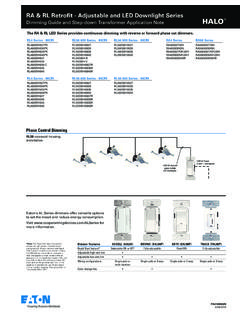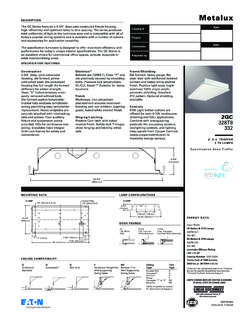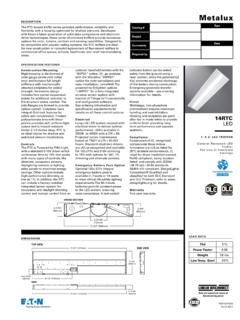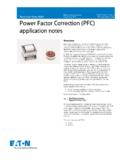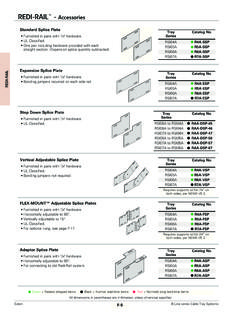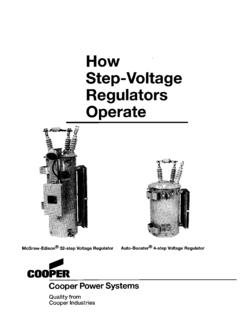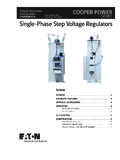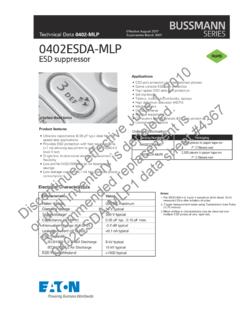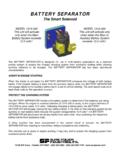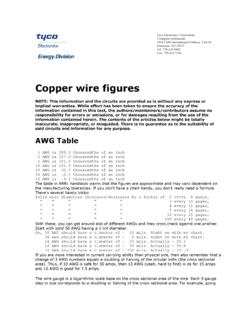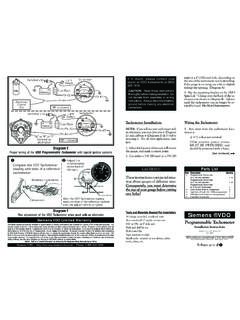Transcription of 10483 SRIES Fuse Technology - Cooper Industries
1 Effective January 2016 fuse Technology :Terminology, Specifications and Device SelectionOverviewVirtually all electronic devices from portable electronics and consumer devices, automotive, military and aerospace applications require some degree of protection against overcurrent events. The most economical and most common form of overcurrent protection is the fuse . Eaton offers an extensive selection of fuses in a variety of configurations. Selection of the proper fuse for a specific application involves consideration of a staggeringly large number of parameters, This Technical Note on fuse Technology will discuss basic fuse operating, application and selection criteria. Overcurrent fuses serve two main purposes: To protect components, equipment and people from risk of fire and shock caused by overcurrents To isolate sub-systems from the main system once a fault has occurredOvercurrentAn overcurrent event exists when the normal load for a circuit is exceeded.
2 It can either be an overload or short circuit condition. Components and equipment can be damaged by both types of overload condition is any current flowing within the circuit path that is higher than the circuit s normal full-load current. An overload is typically two to five times the magnitude of a circuit s normal operating short circuit condition is an overcurrent event that leaves the normal current path, and which greatly exceeds the normal full load current of the circuit by a factor of tens, hundreds or thousands. Selecting Overcurrent ProtectionDuring normal load conditions, a fuse must carry the normal operating current of the circuit without experiencing nuisance openings. However, when an overcurrent occurs, the fuse must interrupt the overcurrent and withstand the voltage across the fuse after internal properly select a fuse the following criteria must be considered: Voltage rating (AC or DC voltage) Current rating Normal operating current Ambient temperature Overload conditions and opening times Available short circuit current Melting Integral (I2t) Pulse and in-rush characteristics Characteristics of equipment or components to be protected Physical size and available board space Standards requirementsVoltage RatingsThe voltage rating of a fuse must be greater than or equal to the maximum open circuit voltage.
3 Because the fuse has such low resistance, the voltage rating becomes critical only when it needs to open. The fuse must be able to open quickly, extinguish the arc after the fuse element Technical Note 10483 BUSSMANNSERIEShas melted, and prevent the system s open-circuit voltage from re-striking across the open fuse RatingsThe current rating of a fuse identifies its current-carrying capac-ity based on a controlled set of test conditions. Each fuse is marked with its current rating. This rating can be identified with a numeric, alpha or color code mark. Marking codes can be found in each product s data Operating CurrentThe normal operating current of a circuit is the level of current drawn (in RMS or DC amperes) after it has been energized and is operating under normal conditions.
4 An operating current of 80% or less of rated current is recommended for operation at 25 C to avoid nuisance openings. For example, a fuse with a current rating of 1A is usually not recommended in circuits with normal operating currents of more than 800mA. Further derating is required at elevated ambient TemperatureAmbient temperature is the temperature of the air immediately surrounding the fuse and is not necessarily room temperature. All electrical characteristics of a fuse are rated and validated at an ambient temperature of 25 C. Both higher and lower ambient temperatures will affect a fuse s opening and current carrying characteristics. This effect is demonstrated in temperature derat-ing Conditions and Opening TimesSpecific attention must be given to first overload operating points.
5 For fuses, the first overload point is usually between 200% to 300% of rated current, with 400% typically being the first overload point for circuit Capacity / Interrupting RatingA fuse must be able to open the circuit under a short circuit condition without endangering its surroundings. The breaking capacity or interrupting rating of a protective device is the maximum available current, at rated voltage, that the device can safely open without rupturing. The breaking capacity or interrupt-ing rating of a fuse must be equal to or greater than the available short circuit current of the IntegralThe melting integral of a fuse , commonly referred to as I2t, is the thermal energy required to melt a specific fuse element. The construction, materials and cross sectional area of the fuse element will determine this value.
6 Each fuse series and ampere rating utilize different materials and element configurations; therefore, it is necessary to determine the I2t value for each fuse . Tests to determine the I2t of a fuse are the rated current with a time constant of less than 50 microseconds in a dc test circuit. High-speed oscilloscopes and integral programs are used to measure very accurate I2t values. I2t data is depicted in a time vs. current graph (Figure 1).The melting I2t of a fuse is one of the values used to assist circuit designers when selecting and properly sizing a fuse in a specific application. It can be compared to the thermal energy created by transient surge currents in a vs. Current CurvesA time current curve represents the relationship between a fuse s melting or clearing time and the magnitude of RMS or DC current.
7 The characteristics represented on most published graphs usually indicate a fuse s average melting time when subjected to a certain level of current. The curves will typically demonstrate the ability to carry 100% of rated current. They also represent the fuse s ability to open within the maximum opening time at designated overload points (typically 135% to 300% of the fuse rating).Time vs. current curves offer a useful design aid for engineers specifying a fuse type or rating for an application. It is, however, recommended that fuse samples be tested in the actual applica-tion to verify and Pulse Current CharacteristicsTransient surge or pulse currents are used to describe wave shapes that result from any startup, inrush, surge or transient currents in a circuit.
8 The pulse currents are normal for some appli-cations. It is therefore important to size the fuse properly to allow these pulses to pass without nuisance openings or degradation of the fuse element. The fuse must then open within the limits specified by UL and CSA standards if the overload condition Figure 1. Time vs. Current Curves for Model S505 SCH time-delay, high I2t fuseFuse Technology :Terminology, Specifications and Device SelectionTechnical Note 10483 Effective January 2016 EATON The ability to resist surges is a function of the fuse design and/or classification relative to the surge pulse, duration frequency and so currents can produce thermal energy that may not be large enough to open the fuse but could possibly cause element fatigue and decrease the life of the fuse .
9 To properly size a fuse and determine its surge withstand capability, the circuit s pulse energy should be determined and compared to the time current curve and I2t rating of the fuse . The fuse s melting I2t value must be greater than or equal to the pulse I2t multiplied by a pulse peak current and decay time define the pulse current char-acteristic or waveform. Pulses can generate different waveform shapes, which determine the formula used to calculate the pulse energy or I2t. Figure 2 shows how to select the appropriate wave-form and its corresponding pulse I2t Withstand CapabilityA fuse s capability to withstand a surge pulse without causing thermal stress to the fuse element, which may result in nuisance openings, can be determined once the circuit s pulse I2t is calcu-lated.
10 A circuit designer needs to properly size the fuse so that the fuse s melting I2t value is greater than or equal to the pulse I2t multiplied by a pulse factor Fp (I2t fuse I2t pulse x Fp).The pulse factor is dependent on the construction of the fuse element. A wire-in-air constructed fuse element ( , ferrule fuses, 6125 and 1025 series) will be affected by the number and frequency of surge pulses the fuse is subjected to over the life-time of the device. This construction design utilizes low-melting-point metals plated or deposited on the main element material to cause an M effect. If the fuse is sized improperly, low-level pulse currents may cause the low-melting-point metals to alloy to the element without completely opening the series of pulse currents will eventually create enough heat to shift resistance or even permanently open the fuse .
